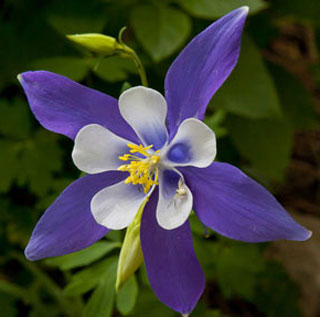
The deciduous varieties bloom spring through fall. If you’re looking for evergreen purple flowering shrubs, it’s important to know that deciduous azaleas are hardier than evergreen azaleas. The flowers grow densely across the low-lying shrub. Besides many shades of purple, you’ll find this flowering shrub in every shade of pink, red, white, and yellow. Part of the genus Rhododendron, they are almost tropical in appearance. It’s easy to see why! They have beautiful, trumpet-shaped flowers in bright colors.
#Purple flowers colorado full
Sun Exposure: Partial sun to full shadeĪzaleas are some of the most popular of all flowering shrubs.Plant Type: both evergreen and deciduous shrubs.Let’s jump in and take a look at the top bushes with purple flowers for your home garden!Īzaleas Azaleas need watering if the foliage becomes dull and loses turgor. Some are deciduous shrubs, which means they die off in the frost and return the following year. Many of these are evergreen shrubs that will have leaves throughout all for seasons. We’ve taken the guesswork out of finding your next purple flowering shrub, but putting together a comprehensive list with some of our favorites. Shrubs, which are woody plants similar to trees, are generally more permanent fixtures in your yard, so picking the right type of shrub is important! Not to mention, you’ll have to consider if it’s hardy to your local climate. It can also add a burst of color to an assortment of white flowers, adding a bit more drama to your gardening space.įinding shrubs with the perfect shade of purple can be challenging, due to the sheer number that are available. The right bush with purple flowers can add a feel of “royalty” to an otherwise tame colored garden space. Well-established clematis will bloom for generations.įor more information, see the following Colorado State University Extension Fact Sheet.Purple flowering shrubs can bring color to your yard all year. These include Clematis x jackmanii and Clematis ‘Ernest Markham’ hybrids among others. Types that bloom on the current year’s growth should be cut back in early spring to the first pair of healthy buds. Large-flowered Clematis ‘Henryi’ and Clematis ‘Elsa Spaeth’ hybrid types also should be pruned this way. Prune plants after flowering to remove deadwood. Woody-stemmed types like the Clematis montana bloom early on last year’s stems. There are two different kinds of clematis and you need to determine which kind you have before you prune. However, clematis roots do poorly when the soil around them is water-logged. Keep plant roots moist and cool by using mulch. The crown, the part of the plant where the stem and roots meet, should be about two inches below the soil. Plant clematis in a soil that drains well and is amended with organic matter such as compost. A trellis or other support is helpful in windy periods. Vines do best in full sun and bloom poorly when planted in areas that have less than 6 hours of sun per day.

In Colorado, planting clematis in the spring is generally more successful than fall planting. Flower shapes range from large, eight-inch hybrids to the dainty bells and honeysuckle blooms of autumn clematis. Hotter shades of red and yellow are also available. The best known flower colors are the cool shades of purple, blue, pink and white. Clematis (Greek word meaning vine) is one of the flowering vines better adapted for Colorado.


 0 kommentar(er)
0 kommentar(er)
